Monday 27 September 2010
The Black Rat - and its 'tall tails'!
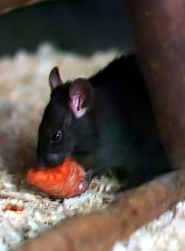
The Black Rat (
Rattus rattus) is also known as ship rats, house rats and roof rats. They have acquired these names because of their preferences for inhabiting large ships and nesting in high places such as trees and the upper floors of buildings. These rats thrive in areas inhabited by humans and are found on every continent (thanks to their instinct for ‘stowing away’), near coastal areas. Tropical regions are where they flourish but some data shows that they have been able to adapt to colder climates; this being due to the fact that Norway rats have pushed them out of many of their original habitats. This species rarely swims and is not found in aquatic areas or sewers, preferring instead, forests, agricultural areas, grasslands and any place that supports their mainly vegetarian diet.
Males of the species are often heavier and longer than females and are not solely identified by being black in color; in fact, the rats can be brown, white, grey or agouti. They weigh between 70-300 grams (2.5-10.6 ounces) and are 16-22 centimeters (6.3-8.7 inches) in length. Interestingly the tail of a black rat almost always measures longer than the rat’s body, at about 19 centimeters (7.5 inches) in length.
The species mainly eats fruits, vegetables, grains and vegetation but is an omnivore and has occasionally been known to eat insects or invertebrates. It needs only 15 grams (.52 ounces) of food and 15 milliliters (.51 fluid ounces) of water a day to survive. Its predators consist of house cats,
birds and other carnivorous animals. This species of rat is plentiful in many areas and therefore, is not in any way endangered.
Female rats will produce up to 5 litters per year with the gestational period ranging from 21-29 days. Breeding occurs year round and the young are made independent from their mothers between 3 and 4 weeks of age. They begin reproducing at 3 to 5 months old. Males do not have much to do with raising the young as they move from one female to another, mating. Nests, which are made out of sticks and leaves and sometimes found in burrows, are tended by the females.
Black rats are very vocal animals and are known for stripping bark off trees and contaminating human food sources. However, they are probably best known for being the animals that carried the fleas which spread the
bubonic plague.
Picture of the black rat by Liftarn, licensed under
GFDL
You can help spreading the word about this animal by liking it on facebook
Permanent Link
Wednesday 22 September 2010
The Malayan Porcupine - An Elusive Asian Rarity
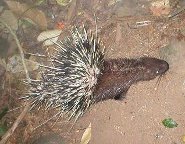
The
Malayan porcupine (
Hystrix brachyura) is a rare and elusive creature that lives in many areas of Asia including but not limited to India, Malaysia, Nepal, and Vietnam. They are found living in altitudes from sea level to approximately 1,300 meters above sea level. With a usual life span of 20-27 years depending on environmental and encroaching human building and population factors, they can weigh from 1.7 pounds (0.760 Kg) to around 5.4 pounds (2.414 Kg) and can reach a length of 83.5 cm (32.9 inches) including their long tails. These animals are very shy and prefer to wander and forage for food at night. They are predominantly nocturnal and are rarely seen for any reason during the day unless threatened or sick.
With a huge habitat range of nearly the entire continent of Asia and even further into neighboring continents, the Malayan porcupine is one of the most widely yet sparsely spread out rodents on Earth. What makes the habitat of these creatures unique, however, is the type of terrain that they live in. They live in heavily wooded areas and make their dens in rocky areas of the ground. Malayan porcupines create burrows which lead into huge networks of tunnels beneath their surrounding habitats, allowing them to get around during the daytime without being exposed to sunlight. They live with other adults of their species and usually produce litters of two or three pups after a pregnancy of around 110 days.
The Malayan porcupine is covered at birth with soft quills which sharpen into rigid, hard quills upon reaching adulthood. This is the animal's defense mechanism and is effective to most predators and hunters that come after these porcupines. Though not predators themselves, they eat fruits, roots, nuts, and insects, as well as carrion (or dead animal matter).
In general, the Malayan porcupine is endangered because of over-hunting and human overpopulation into their habitats. There are tribes of people who eat them and who use their quills for decorative purposes. They are also hunted by feral cats, some types of wild hogs, and other predatory animals that live in the same region as they do. In some countries like Vietnam, their paws are considered good-luck charms just as rabbits' feet are in the United States. Without a little consideration and help from mankind, this unique species will become extinct very quickly. The International Union for Conservation of Nature ranks the Malayan porcupine as a vulnerable species with a high likelihood of facing extinction in the wild. This is due to the fact that they are hunted for their meat. They are also hunted to be displayed as decoration for their unique quills and coloring.
You can help spreading the word about this animal by liking it on facebook
Permanent Link
Monday 20 September 2010
The Thomson's Gazelle - East Africa's Most Stubborn Creature
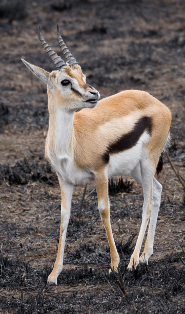
The
Thomson's gazelle (
gazella thomsonii) is the most common gazelle in East Africa. Although they are not as widespread as the Grant's gazelles, they can be found on ranches and farmland throughout East Africa, and persist long after other species have been killed off or migrated away.
Thomson's gazelles are commonly referred to as "tommies". Tommies stand at about half a meter (22-26 inches) tall and weigh in between 15 and 25 kilograms (35-55 pounds). Although very similar in appearance to the Grant's gazelle, they have some distinguishing features. Thomson's gazelles are slightly smaller in size compared to their cousins. In their coloring, tommies have a dark stripe that stretches from shoulder to flank, as well as a white patch on their rump. Females have either no horns, or very small, short, smooth horns. Males, which are larger, have a large ridged horns that curve back on their head.
The tommy has adapted to drier life on the open plains of East Africa, primarily in southern Kenya and northern Tazmania. Although tommies have many predators, including
cheetahs,
lions,
leopards, and hyenas, they are frequently the last animals left on an abandoned ranch or farmland. They thrive by subsisting on the short, dry, remains of grasses left by the cattle, which make up 90% of their diet during dry seasons. Although they have many natural enemies, this disadvantage is balanced with fine senses of hearing, smell, and balance. Despite their persistence, many tommies fall victim to human gunshot.
Due to their vulnerability from predators, tommies form groups for protection. The strongest males set up territories by using exaggerated posing, marking their territory, and vigorously defending their territory with their horns. The groups consist of 5-50 females and their offspring, which wander through the male territories. These groups change in numbers, composition, and leadership as frequently as once an hour. Thomson's gazelles recognize others in their species or group by the largely visible black stripe and communicate disturbance through foot stamping. They breed twice a year, with a gestation period of six months. Due to the heavy threat of predation, approximately 50% of young tommies are lost as victims of prey.
While tommies are stubborn creatures that can subsist where other animals cannot, there has been a 60% decline in their population over the past 30 years. With a population estimate of 550,000, these animals are protected in many parks.
Picture of the Thomson's gazelle by Ikiwaner, licensed under
GFDL
You can help spreading the word about this animal by liking it on facebook
Permanent Link
Thursday 16 September 2010
The Pesty Striped Field Mouse
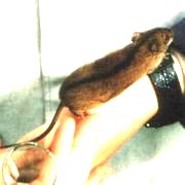
The
Striped Field Mouse (
Apodemus agrarius) is one species of mouse that owes its name to the black or dark stripe that goes down its spine. This rodent is natural to Europe and regions stretching all the way to Japan, including the regions of Siberia and Taiwan. This mouse is not considered a threatened species, rather of least concern according to conservation status classification. Its color is a light rich yellow-brown, which makes the dark striped along its back more prominent.
This little rodent can grow to be 70-140 mm long, but its tail can add 61-96 mm to those measurements. Its weight ranges from 12-49.5 grams approximate. This species can reproduce all year. Females usually have eight nipples and can give birth to six litters yearly; each litter may have up to six mice.
The striped field mouse likes to live in prairies, grasses, rice fields, the woods, gardens, marshes, cornfields, reedbeds, and forests. It is agile and capable of swimming and leaping. It lives in holes underground, which it inhabits during the nighttime, as this mouse is a diurnal animal. However, these patterns may change with the seasons becoming nocturnal during the summer, and diurnal during the cold months of winter. In autumn, it can be found during night and day. It prefers environments that have lots of foliage and a variety of grasses and vegetation and moist areas. It does not like arid areas or areas where the vegetation is not varied such as large forests. It is considered a species that is very widespread in Europe and beyond. Its diet consists mostly of insects and grains, seeds, berries, nuts, and plant roots. However, if found on wrong territory or environment it can damage food stores supplies or farm crops. It is considered to be a pest for agriculture. It has been known to be a carrier of hemorrhagic fever (HTNV).
In captivity, the diet should match what it eats in the wild as close as possible. This may include mouse mix of grains and seeds, green veggies, some servings of fruit, crickets, captive bred worms, wheat bread, and cheerios - the last two as a small quantity treat. However, junk food such as salty foods, chocolate, and other treats might harm these critters so it should never be fed to them. A vitamin supplement such as Nutrical - usually sold by veterinarians - is beneficial in very small quantities and reduced amounts and not to be overdone.
The reproduction of this species is high and natural occurrences such as rains, small predators, and freezing soils keeps it under control.
Picture of the striped field mouse by Silke Sohler, licensed under
GFDL
You can help spreading the word about this animal by liking it on facebook
Permanent Link
Wednesday 15 September 2010
The Spot-Billed Duck has it right on the nose!
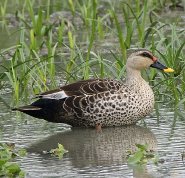
The
Spot-Billed Duck (
Anas poecilorhyncha) is known by many names including the Yellow-Nib, Indian Spot-Billed, Spotbill and Chinese Spotbill, as well as being locally known as Garm Pai or Gugral. Its name comes from the red spots at the base of their yellow-tipped black bills, which the females of the species lack.
Spot-bills are native to Asia, being found largely in Haryana, India, but also in China, Japan and the USSR. They live in freshwater lakes, ponds, rivers and marshes and are normally found in waters with a depth of 0-1,867 meters or 0-6,125 feet.
They nest on dry ground on top of piles of thick moss, grass, feathers and/or down. Relationships in this species are monogamous and females will lay 7-10 white colored eggs that she incubates for 26-30 days. These ducks are known to hybridize (mate with other similar species of duck) naturally with mallards and in captivity, with the Pacific Black Duck and the
Philippine Duck. Breeding season differs between north and south India and with water levels: i.e. from July to October in Northern India and November to December in Southern India.
Both genders are similar in appearance having scaled brown bodies, a blue speculum with white borders on their wings, a dark brown crown, nape and eye stripe and orange legs and feet. They are a rather large species with a length ranging from 53-58 centimeters or 21-23 inches and a height of 40-81 centimeters or 16-32 inches. They have a tapered wing shape with a wingspan range of 76-94 centimeters or 30-33 inches and a fan-shaped tail. Juveniles tend to be an overall gray color.
These ducks are "dabbling ducks" meaning that they do not dive for their meals but instead stick their heads underwater with their tails in the air to forage. Spot-Billed Ducks will also graze on dry land for their food. They eat seeds, snails, grasses and aquatic plants and normally weigh about 62 grams or 2.2 ounces. They are also considered to be very social ducks and can sometimes be found in groups as large as 50 or more.
The Spot-Billed Duck has a rating of "Least Concern" on the endangered species list due to its wide range and population. Some predators of this duck would be large fish, such as the European Pike, foxes and snakes, which mostly threaten the eggs while in the nests and newly hatched ducklings.
Picture of the Spot-billed duck by Lip Kee Yap, licensed under the
Creative Commons Attribution-Share Alike 2.0 Generic license.
You can help spreading the word about this animal by liking it on facebook
Permanent Link
Monday 13 September 2010
The Giant Trevally - The Muscle Car of the Ocean
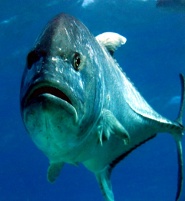
The
Giant Trevally (
Caranx ignobilis) is a powerful oceanic predator fish also known as the GT for short. It’s also called the Giant Kingfish, the Lowly Trevally, or the Barrier Trevally. Like the Mustang GT muscle car, this GT has its own muscle power: strong and thick midsection, and is distinguished by its steep and blunt head shape, and 26 to 38 scutes (sharp, bony plates) along its lateral line. Its color ranges from silver to black, and on those with darker color, it can have remarkable silvery-white patterns on its upper body.
The GT reaches its full size at 3-4 years. Typical size 60 cm long (1.969 feet, or .6 meters) but have been recorded with a length of 170 cm long (5.577 feet, or 1.7 meters) and a weight of 80 kg (176.4 pounds).
The distribution of the Giant Trevally occurs in the tropical or coastal areas of the Indian and Pacific Oceans. The range extends from the eastern coast of Africa, along the coasts of India and Pakistan, across the coast of northern Australia, to as far east as Hawaii. Its habitat is in the shallow coral reefs and lagoons and channels in these tropical areas.
With its canines in its upper jaw, and conical teeth in its lower jaw, the GT has been known to consume small turtles and dolphins. However, its main diet consists of most baitfish found in tropical waters, and it supplements its diet with lobsters, squid, and octopus. The Trevally’s method of operation is to use its muscled body to body slam its prey into stunned submission and then quickly eat before another competitor can take away the spoils. The GT also follows
Monk Seals and reef sharks to their feeding grounds, and waits for when the shark or seal’s attention is diverted, and then grabs what it can of the other predator’s dinner.
The GT is prey to only two other predators: sharks, and man. Its biggest threat is population decline, which is largely suspected as due to erosion of coral reefs, which are the GT’s main habitat. While it remains a popular game fish in the Indo-Pacific region, its numbers have been decreasing around Hawaii. So far, fishing for the Giant Trevally has not been banned but anglers are being encouraged to follow a catch and release method instead. Recommendations are to have the fish out of water for no more than 30 seconds, to use a hose to pump saltwater through the gills, to use barbless hooks, to not hold the fish by just the mouth, gills, or tail, to hold it securely and not allow it to drop or hit against anything, and to gently swim it a bit before releasing it.
You can help spreading the word about this animal by liking it on facebook
Permanent Link
Friday 10 September 2010
Guianan saki - Doing the Unexpected
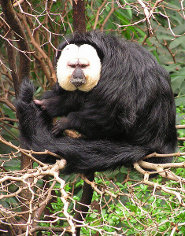
The
Guianan saki (Pithecia pithecia) or White-faced saki is one among several species of saki monkey from the New World. It is a small, shy monkey that rarely touches the ground and prefers a quiet family life. However, it can roar with power to protect its territory and leap through the air from tree to tree for up to 10 meters.
It lives with its lifelong mate in the understory and lower canopy of the rainforests in northern and central South America. It lives in Brazil, French Guiana, Guyana, Suriname, Venezuela and Peru. In its family group it communicates with twitters and shrill cries which are unique for each family, however, it can roar to warn other animals and saki monkey families away from its territory. The Guianan saki monkey does not swing through the trees by its tail, because it does not have a prehensile tail. It mainly walks on all fours but does stand on two feet to jump between branches.
Parents and offspring move together (called a federation) and protect their territory. They groom each other, which creates a bond in the family and often older siblings will care for the young ones. Adults weigh approximately 1.48 kg (3.256 lbs) and are 30 to 50 cm long (11.81 to 19.69 in). Their long, bushy tail doubles their size. They live up to 36 years.
The females mature earlier at a little over 2 years while the males mature at approximately 4 years. They have one offspring at a time, once a year. There is no season for mating, it happened throughout the year. The gestation is from 150 to 180 days. It is easy to tell the difference between the males and females. The males have black fur with, a reddish-white face and females have shorter hair with brownish-gray fur and light brown stripes around the nose and mouth. Their fur fringes around their foreheads and looks like little hoods.
They eat fruits, flowers, insects, leaves and nuts and spend much of the day resting. In Guiana, White-faced saki have been seen looking into tree hollows and collecting bats which they tear apart and eat. Eating and playing during the day, at night they curl up like cats and sleep in the tree branches. The biggest cat of the rainforest, the
jaguar, would prey on Guianan saki monkeys, but they are themselves endangered.
On the IUCN (International Union for the Conservation of Nature and Natural Resources) Red List of Threatened Species the Guianan saki monkey is classified as LC (Least Concern). Two recognized subspecies are
Pithecia pithecia pithecia and
Pithecia pithecia chrysocephala.
Picture of the guianan saki by
Skyscraper, licensed under
Creative Commons Attribution 3.0 Unported
You can help spreading the word about this animal by liking it on facebook
Permanent Link
Wednesday 08 September 2010
The Greater Hedgehog Tenrec - Spiny & Solitary
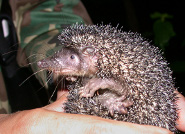
The
greater hedgehog tenrec (
Setifer setosus), also called the Madagascan hedgehog or Madagascar tenrec, is native to northern and eastern Madagascar. Though they are similar to hedgehogs, the Madagascar tenrec has a larger body and a more rounded snout. Like a hedgehog, their backs and tails are covered in short, sharp spines; while their legs and undersides sport a softer fur. Madagascar tenrecs range in length from 6 inches to just shy of 9 inches (15-22cm) and range in weight from 6.3 to 9.5 ounces (180-270 grams). Their spines are black with white tips, though the fur may be light or dark in color.
The Madagascan hedgehog can be found primarily in dry forests or agricultural areas, though they may also be found in more humid or subtropical forests and highlands all over Madagascar. Their varied diet consists of fruits, insects, earthworms, reptiles and amphibians, and even carrion. During colder winter months, the Madagascar tenrec will often stick to a smaller foraging area or, if conditions are particularly tough, go into torpor. Torpor, something different than
hibernation, is a state of inactivity or suspended activity in which an animal’s bodily functions slow down to conserve energy and let the animal survive bad weather.
The greater hedgehog tenrec is nocturnal and generally a solitary animal. Though its habitat is widespread, individual animals do not interact much outside of mating season. Their breeding season occurs during September and October, with females giving birth after 51 to 69 days. Litters can range in size from one to five, with three being the average. The young are weaned around 24 days, which seems relatively short as the greater hedgehog tenrec can live for up to 14 years.
The Madagascar tenrec is different from other tenrecs in that its defense mechanism is more docile. Rather than using its spines to attack potential enemies, it behaves more like a traditional hedgehog, rolling into a ball with its spines out. This spiny ball offers the tenrec protection from predators, which may include birds of prey, snakes, and carnivorous mammals called viverrids. Though it is unrelated to the hedgehog, the fact that Madagascar tenrec shares this particular trait is why it is called a hedgehog.
On the International Union of Conservation of Nature and Natural Resources (IUCN) list of threatened species, the threat to the greater hedgehog tenrec is low. No foreseeable threats loom that may harm the population of these solitary, spiny creatures, and they are therefore not considered endangered.
In the vast variety of creatures on the island of Madagascar, the greater hedgehog tenrec may seem small. But this little animal differs both from hedgehogs and other tenrecs, giving it a unique personality in the world of mammals.
Picture of the greater hedgehog tenrec by Tom Junek, licensed under the
Creative Commons Attribution-Share Alike 3.0 Unported license.
You can help spreading the word about this animal by liking it on facebook
Permanent Link
Friday 03 September 2010
The Indian Gray Mongoose - A Ruthless Cobra Killer
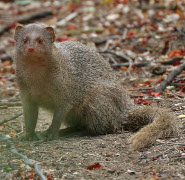
The
Indian gray mongoose (
Herpestes edwardsii), also known as the Common grey mongoose, is predominantly found in Sri Lanka and southern India although the species can also be found in other locations such as Iran, Saudi Arabia, other areas of India, and some areas of southeast China.
Unlike other forms of wildlife, the Indian gray mongoose is often found close to the dwellings of humans, particularly in areas of tall grass and trees. They are also found in areas of dense vegetation as well as in cultivated farmland. The animal creates its den in burrows and holes and occasionally under rocks and crags. It often lives alone or in the companionship of another of its species. Although very curious, it is rare to see the mongoose venture far away from its den and natural habitat.
The Indian gray mongoose is typically between 14 and 17 inches in length or 36 and 45 centimeters. The tail length of the mongoose is usually about the length of the body, about 17 inches or 45 centimeters. Its long tail length allows for the mongoose to be a very apt climber because of its added ability to balance. The species weighs between 2 and 4 pounds or 0.89 and 1.7 kilograms with the females being significantly smaller than the males. Their coloring is typically a tawny grayish brown color with their underside being lighter than their upper body. The Indian gray mongoose typically lives about 12 years in captivity.
The Indian gray mongoose has a varied diet consisting of rats, mice, other rodents, small birds, bird’s eggs, invertebrates and lizards. They are also known to kill snakes including cobras which requires a great deal of speed and agility. It is one of the only species that is known for its ability to kill these deadly snakes as well as other poisonous snake species. Their ability to kill these potentially fatal animals is due to their speed as well to their exceptionally thick, course coat.
The mongoose is an avid predator and is capable of defending itself against a variety of species. However, the primary predators of the Indian gray mongoose are the
leopard as well as the snakes which the mongoose has been known to engage in fierce battle.
The species typically reaches sexual maturity between 6 to 9 months of age and soon after, begins to mate. Another characteristic which makes the Indian gray mongoose so unique is that they do not have a specific mating season. Instead, the mongoose breeds all year long with a gestation period of approximately 60 to 65 days. The litter of the mongoose ranges in size but usually consists of about 2 to 5 babies.
The Common gray mongoose, as its name suggests, is the most common species of mongoose and is not considered endangered. The species is listed as a Least Concern meaning that there is no immediate risk that the mongoose will become extinct. Although this species is not in immediate danger, there are other species of mongoose which are listed as endangered.
Picture of the Indian gray mongoose by J.M. Garg, licensed under
Creative Commons Attribution-Share Alike 3.0 Unported license.
You can help spreading the word about this animal by liking it on facebook
Permanent Link
Thursday 02 September 2010
Southern red-backed vole - Traveling on a Pogo Stick
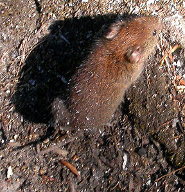
The Southern red-backed vole (
Clethrionomys gapperi) hops through the forest, along old logs, across a bed of moss and up a tree stump. Always in a hurry, it sometimes runs but is most often seen hopping along the cool, damp forest floor.
It lives in bogs, swampy areas and coniferous or mixed forests from British Columbia to Newfoundland and in the northern U.S. in the forests of the Rocky Mountain system to Arizona and New Mexico. It lives in North and South Dakota, Minnesota, Wisconsin, northern Michigan and in New England south to Maryland. Also, in the Allegheny Mountain system to North Carolina and the Appalachian Mountains.
From the family of Muridae, mice and rats, it is small, only 120 – 158 mm (4 ¾ - 6 ¼ in) long and 30 – 50 mm (1 1/8 – 2 in) tall. It weighs 16 – 42 g (1/2 – 1 ½ oz). Its hind foot is 17 – 22 mm (5/8 – 7/8 in) and its tail is 35 – 50 mm (1 3/8 – 2 in) long. It has reddish fur on its back, grayish sides and white or silver on the belly. The tail is also two toned with brown on top and white below. The fur is a little longer and denser in the winter, but with a life span of 20 months maximum, not many live for two winters.
When they don’t feel like finding one of their own, the Southern red-backed vole borrows the nests of shrews and moles. Sometimes, they nest in the exposed roots of trees and crevices of rocks, but they do not construct elaborate nests. The male, female and young will stay together until the young get older when the male usually moves out.
Most Southern red-back voles live 10 to 20 months and start breeding at 2 to 4 months. Females typically have three litters of 2 to 8 young per year from late winter to late fall. Gestation is 17 – 19 days and the young are born hairless and pink with closed eyes and ears. By 17 days they are weaned.
The most common predators are
Short-tailed Weasels and Broad-winged hawks, but
Coyotes and
Gray Wolves sometimes make a meal of the southern red-back vole. In the Great Smoky Mountains National Park one was found in the stomach of a
timber rattlesnake.
The Southern red-backed vole is mainly vegetarian preferring plant parts in the spring, fruits and berries in the summer and nuts, seeds and possibly mushrooms in the fall. Occasionally, they eat some insects. They store food in the summer and fall that they will eat in the winter, and they also look for seeds, bark and roots. They are active day and night and all year round. They do not hibernate in the winter and hardly ever slow down as they hop through their short active life.
According to the International Union for Conservation of Nature Red List, the Southern red-backed vole is Least Concern (LC) on the endangered species list. This means the population is stable.
Picture of the southern red backed vole by D. Gordon E. Robertson, licensed under
Creative Commons Attribution-Share Alike 3.0 Unported license.
You can help spreading the word about this animal by liking it on facebook
Permanent Link
 The Black Rat (Rattus rattus) is also known as ship rats, house rats and roof rats. They have acquired these names because of their preferences for inhabiting large ships and nesting in high places such as trees and the upper floors of buildings. These rats thrive in areas inhabited by humans and are found on every continent (thanks to their instinct for ‘stowing away’), near coastal areas. Tropical regions are where they flourish but some data shows that they have been able to adapt to colder climates; this being due to the fact that Norway rats have pushed them out of many of their original habitats. This species rarely swims and is not found in aquatic areas or sewers, preferring instead, forests, agricultural areas, grasslands and any place that supports their mainly vegetarian diet.
The Black Rat (Rattus rattus) is also known as ship rats, house rats and roof rats. They have acquired these names because of their preferences for inhabiting large ships and nesting in high places such as trees and the upper floors of buildings. These rats thrive in areas inhabited by humans and are found on every continent (thanks to their instinct for ‘stowing away’), near coastal areas. Tropical regions are where they flourish but some data shows that they have been able to adapt to colder climates; this being due to the fact that Norway rats have pushed them out of many of their original habitats. This species rarely swims and is not found in aquatic areas or sewers, preferring instead, forests, agricultural areas, grasslands and any place that supports their mainly vegetarian diet.
 The
The  The
The  The
The  The
The  The
The  The
The  The
The  The
The  The Southern red-backed vole (Clethrionomys gapperi) hops through the forest, along old logs, across a bed of moss and up a tree stump. Always in a hurry, it sometimes runs but is most often seen hopping along the cool, damp forest floor.
The Southern red-backed vole (Clethrionomys gapperi) hops through the forest, along old logs, across a bed of moss and up a tree stump. Always in a hurry, it sometimes runs but is most often seen hopping along the cool, damp forest floor.